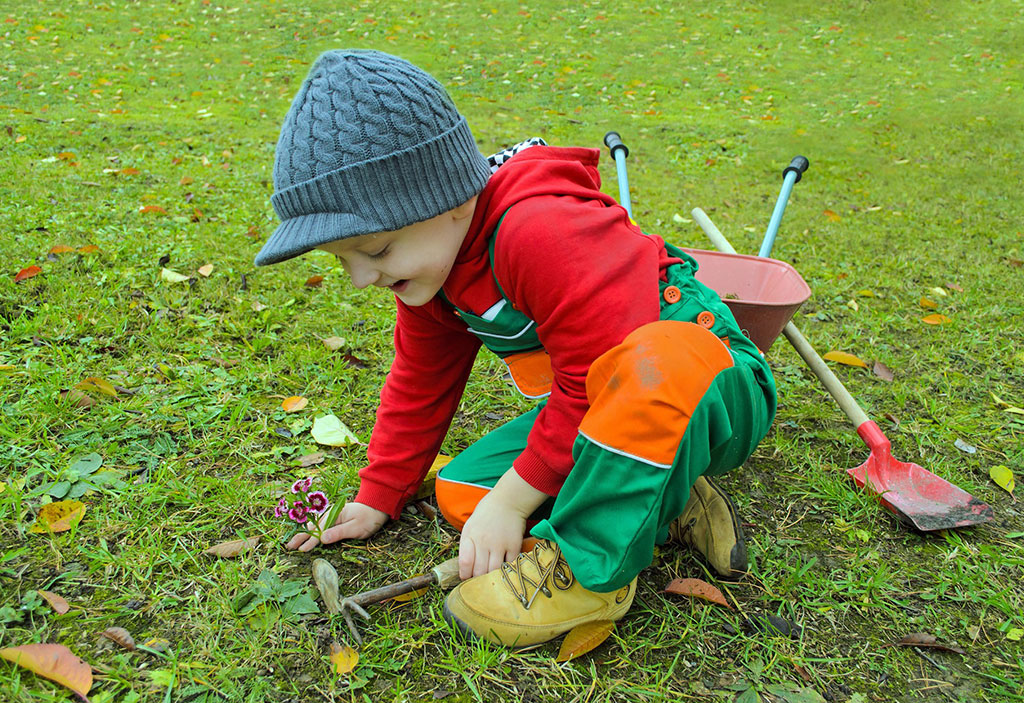10 Easy Plants for Gardening with Your Kids

At one time or another, every parent finds themselves saying to their children: “Go outside”. What better way to get your children, or your busy self outdoors than by growing and caring for plants? Plants are a something that everyone takes pride in when they flourish. Here are 10 plants that are easy for kids to grow and take care of. They are broken into three categories: Garden, Flowers, and House Plants.
Garden
Beans: Two varieties to consider are your Pole and Bush beans (choose the variety you/your children prefer). Pole Beans only require something to climb (teepee, arbor or something else you have designed/created). I love pole beans as it is easy for my children to pick and eat. Bush Beans do not climb, but are otherwise similar to the Pole Bean. A variety to recommend is Purple Queen. These beans ripen purple so children know when they are ready to pick.
Planting: Beans have large seeds which can be planted 1/2 inch deep. Pole Beans need to be planted so they are able to climb once they have emerged. I always have my arbor in place first. I also secure it (I use a post and tie it to the arbor) in the garden so it can withstand heavy rains/winds. Bush Beans are planted in rows. Cover with dirt and water. When the plant emerges it will have a hard stem, which makes it easily identifiable against other weeds that are growing.
Care: Pole Beans may need help when starting to climb. Weed as needed (I find it easier to weed the pole beans) and when it has gone a week without raining, water. If soil is hard and dry water sooner.
Harvest: Depending on the type of bean, they will begin producing between 50-75 days after planting. Once beans are ready to pick they will need to be picked every other day.
Gourds: Gourds are also fun in the garden. There are three different varieties to choose from ornamental (you can decorate them), utilitarian (this has a hard shell and can be used as a tool/utensil/toy), and the vegetable sponge gourd (you can peel the shell and use the sponge in the center).
Planting: Gourds will have the best result if using a wood trellis, be sure it is well secured. Plant gourds 1-2 inches deep after trellis is in place, cover with 1/2 inch of dirt. Due to the rough exterior gourds take longer to germinate. If you want to speed up the germination process, you can use an emery board to scratch the surface of the seed. Then you can soak the seeds for 24 hours and then dry them on wax paper for another 24 hours.
Care: Gourds need lots of water, especially when weather is hot. As they grow up the trellis, secure with string. Weed and use mulch/fertilizer (optional) to help retain moisture.
Harvest: When gourds are fully grown the vine will naturally die. Let them cure on the vine. They will become lighter and lighter and will become hard and slightly waxy. If they are squishy and soft they are rotten and need to be thrown out. When they sound like a rattle when shaken use a scissors to cut. Enjoy the fun the gourds will bring you and your family.
Mint: Mint is an herb and can be planted in your garden or in a pot (recommended) on your deck/porch table. I would recommend planting chocolate mint. This can be fun for kids and adults alike to nibble on and enjoy. This is a perennial and therefore will come back yearly. If you keep it in a pot during the summer, you will need to bring it indoors in the winter or plant it in the soil outdoors (more on this below).
Planting: Purchase chocolate mint from your local nursery. Find a spot that gets morning sun and evening shade, it does not need much for care, just keep it moist. Chocolate mint grows like a weed. A way to contain it is to plant it in a deep bottomless container and put the pot inside.
Care: Mulch around herb before first frost. You can also snip off some of the stem and put it in soil and watch it regrow (makes for a great gift!). Water as needed.
Carrots: The large size that carrots can grow to, their leafy stems and Bugs Bunny’s “What’s up Dock” is enough to get most kids excited about growing carrots. They are also a great snack that your child has grown!
Planting: Using a hoe, make a raised bed and then sow ½ “ deep in rows. Carrot seeds are very small, but you want to have a pinch for every inch. You can start planting three weeks before the last frost and continue planting every two weeks until you are three months from frost. Expect a 1-3 week germination process.
Care: Wait until you see about an inch of growth before starting to weed. You will want to thin carrots out until they are 3”-4” apart. Water as needed, if it is dry and you forget to water, replenish little by little to prevent the root (carrot) from splitting.
Harvest: Pull carrots in the fall. They become tastier as they grow. To check size, remove dirt from the just below the leafy stem, cover again if you don’t pull them. Pull as desired or before the first frost.
Flowers
Sunflowers: Sunflowers may also be planted in a garden. They can grow to a height of 16 feet tall. They will be fun to watch grow as their stems become very thick. The sunflower seeds can also be used for bird seed or salted and roasted to eat. If you have room in your garden, plant sunflowers with a design or pattern, leaving an opening will allow children to enter and play. It may also be fun to get a bird book and identify the different birds that come and get a meal once the sunflowers can be harvested. Sunflowers are annuals and need to be replanted yearly, although you may have some voluntarily regrowth.
Planting: Sunflowers can be planted in trenches in rows or designs six inches apart, 1-2 inches deep. Cover and keep watered and sprout will emerge in 7-10 days.
Care: Sunflowers are tough plants once established. The most important time to water is twenty days before and after flowering. They will be easy to weed as a result of the thick stems. If keeping the seeds, cut off the head once it nods downward.
Zinnias: Zinnias are fun annuals that have large blossoms that are fun to have outdoors or to clip and put in a vase. They are annuals and need to be replanted yearly. They are one of my favorite flowers to plant in the garden or in a flower bed.
Planting: These have large flaky seeds and can be planted 1/2 inch deep and covered with dirt and water.
Care: Wait until plant has emerged and is identified then weed. Water as needed,
increase frequency with hot, dry weather. Clip blooms as desired.
Rock Cress: Rock cress likes hills and slopes and can be used in rock gardens. It is a perennial so it will return year after year. One thing children and adults alike will enjoy is that it can be enjoyed as a flower or eaten. Both the leaves and flowers are edible. Dress up any dish with these flowers or help your children make a cake and top with flowers. It will surely impress all of your guests!
Planting: Plant in full sun covering with 1/8″ of light potting or garden soil. Keep soil moist during germination.
Care: Water only during the hottest and driest parts of the summer. Can add nitrogen fertilizer when first planting and phosphorus fertilizer before blooming.
Nasturtium: Nasturtiums also have edible flowers and leaves; and as they are fast growers children will enjoy watching the fruits of their labor. You can plant nasturtium in the garden, pots or window boxes. They have a peppery taste and can be a great addition in both color and flavor to a salad or used as a garnish. They are annuals and will need to be replanted yearly.
Planting: Plant in full sun. Sow seed 1” deep 10” apart.
Care: Water only when there has been a lack of rain. Let the soil get dry between watering, but not dry out
House Plants
Aloe: Aloe is a great plant to have indoors and is easily to grow and gift. It also comes in handy if you spend too much time in the sun or accidently burn a finger. If you have a burn and need the aloe, simply cut a branch and squeeze out the aloe and apply it to the burn. The aloe plant will heal where you made the cut on its own. They do get top heavy and putting them in a heavier pot can prevent them from tipping over. Purchase or get a pup from someone who already has an aloe plant.
Care: Aloe plants like sun, but if they get too much, they will tell you (that is my kind of plant)! If there leaves get brown they are getting too much sun, put them in shade during evening sun. If the leaves get thin and curled increase your water.
Snake Plant: Ranked as one of the most tolerant plants, this plant is perfect for the busy adult or the forgetful child! Not only is this a neat plant, low maintenance, but it has also been shown to help clean the air in your home.
Planting: The snake plant can be grown well from a cutting, but needs to be planted in free draining soil to prevent rot. To divide the plant remove the roots (which are fleshly) with a sharp knife and potted up.
Care: Place in indirect sunlight and do not overwater. It is better to have the plants dry out a bit before watering.
Pondering Gardens can help design and build your dream garden or landscaping for you and your family. Contact us at here with any comments or questions. Also make sure to like us on Facebook and let us know what easy plants you have grown.
